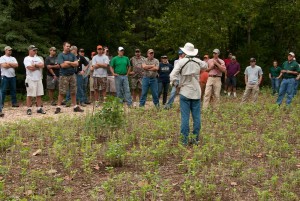How to Plant Successful Food Plots
Filed under: Food Plots, Hunting Blog
I get a lot of requests to publish a calendar that tells when and what to do to have great food plots! I’ve had offers from seed companies, magazines, etc. I could have sold and resold such a calendar. Heck, I probably could have paid for several great whitetail hunts from publishing such a calendar.
The problem is that such calendars seldom are accurate. Planting by such guides seems to result in as many failures as good crops. This is not the authors’ fault. The data for these guides are based on historic weather patterns and averages of climate data. That’s like saying the average man is 5’10” tall. Some men are 5’10” but many more are either shorter or taller than 5’10”.
The same is true for the last frost dates during late winter, the first frost date during the fall, rainfall amounts, etc. Averages rarely predict the best conditions to plant on any given year.
Rather than offer a planting calendar, I will share the guides I use to create successful food plots!
- Take a soil sample from each plot to be planted – at least once a year. I typically collect soil samples during the late winter and when the soil is dry.
- One sample a year will be fine. Don’t skip years! Soil tests are the least expensive part of growing forage that deer wish to consume more than other food items.
- Add lime and fertilizer based on the soil tests results a week or so before planting.
- Clover and alfalfa can be planted when the soil temperature is 40 degrees and up to 60 degrees. The exact planting date within that range should be based on forecast, soil moisture, etc. A hard frost will damage or kill most young forage crops, including clover and alfalfa.
- The temperature today is only half the story. I study the weather forecast and attempt to insure there isn’t more cold weather coming.
- By the way, I’m not a fan of alfalfa for food plots!!! Deer eat it – but it is tough to manage – I leave alfalfa to the professional farmers – not the food plot farmer with limited ability and time to spray harsh insecticides, etc.
- Corn should be planted when the soil temperatures are 50 degrees and rising – not just a spike of 50 degrees.
- Soybeans and almost all other crops should be planted when the soil temperature (2″ deep at 9 AM) is 60 degrees and rising. The timing of this will vary almost every year!!
- Soils warm up later (as much as a few weeks later) in no-till plots compared to areas where the soils have been plowed, disked, etc. This is because the remaining vegetation shades the soil and keeps it cooler – a significant advantage later during the summer. By the way, this is just one of MANY advantages to no-till systems.
Fall planting (soil temperatures are almost never an issue for planting fall crops.)
- I like to plant all forage varieties at least 45 – 60 days before the average first frost date. I like to error on the 60 day side. However, this also varies based primarily on soil moisture availability. I don’t plant into dry conditions with no rain in the forecast – even if it means waiting until 15 days before the average first frost date.
- Remember that plants are only nutrient transfer agents. If there are limited nutrients in the soil, they will only transfer limited nutrients to the consumer (deer and other critters).
- Soybeans are the best single crop for deer and turkey that I’ve found yet. They are relatively drought hardy, easy to grow and deer love them! The only negative to soybeans is that deer do love them so much that beans can be damaged by being over-browsed, especially in small plots. I use an electric fence to keep deer out of these small plots until the beans have matured enough to withstand the browse or hunting season opens.
So, what’s the bottom line? It is this: professional farmers don’t gamble their income (crop production) on a set planting schedule and neither should you. Do your food plot activities based on conditions and not a date on a calendar or a bag map.
Growing Deer (and food plots) together.
Grant




